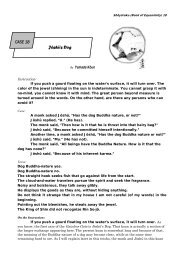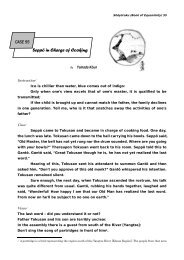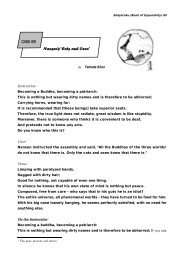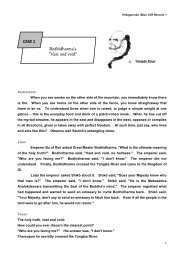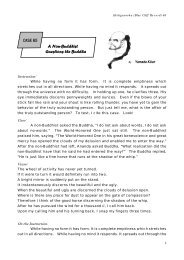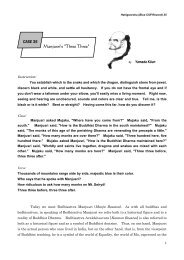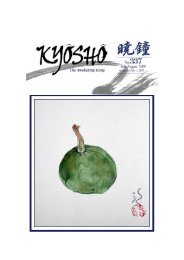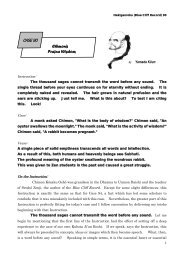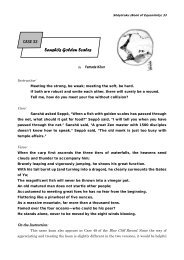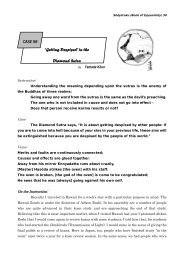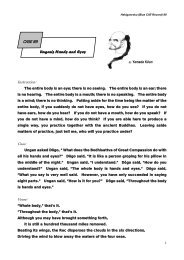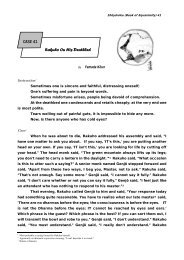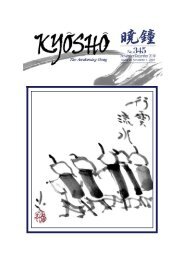You also want an ePaper? Increase the reach of your titles
YUMPU automatically turns print PDFs into web optimized ePapers that Google loves.
Shôyôroku (Book of Equanimity) <strong>21</strong>Ungan raised his bamboo broom, and said, “What number of moons isthis?” That’s a very sharp and trenchant response.Dôgô was silent. We needn’t assume that Dôgô lost the dharma exchange simplybecause he remained silent. The koan has come to its conclusion, its denouement. There isreally nothing left to say or add. So he remains silent. It would not do to say something like“Oh, that’s a second moon!” Silence is golden, and knowing this, Dôgô keeps mum.Gensha said later, “That is precisely the second moon.” As the word “later”indicates, Gensha wasn’t present at the time of the exchange. He heard about that exchangeat a later date. He says that they have fallen away from the essential world. To keep silent isthe best reply.Gensha Shibi Daishi was also rated very highly by Dôgen Zenji. Originally afisherman, he was out fishing one day with his father, when the older man fell from the boat.Gensha tried to save him from drowning but was unable to. Feeling keenly the impermanenceof life, he turned to Buddhism. In rating the Zen masters of the past in his Shôbôgenzô, DôgenZenji is very severe in his estimation, and only a choice few met up to his standards. Anotherone singled out for special praise was Tôzan Gohon Daishi (the founding patriarch of the SotoSchool of Zen). And another, as just mentioned, was Gensha Shibi Daishi.Gensha’s critical comment in today’s koan is really wonderful.Unmon also said later, “The man-servant greets the maid-servantpolitely.” Then Unmon has his say, although, in his case as well, we shouldn’t imagine thathe was on the scene of the exchange between the two monks. He says that Ungan and Dôgôengaged fervently in a vivid exchange, but that was just like a manservant and a maid beingpolite to each other. “It’s so funny I can hardly bear to look,” he seems to say. From Unmon’sstandpoint in his critical comment, it’s as if the two monks are exchanging greetings in a moststately way, as if filled with deep meaning. Unmon and Gensha were both students of SeppôZenji. As the verse to Case 24 of this koan collection indicates, the question on whether thereis a second moon is an attempt to somehow make clear the world of oneness. Persons whohave realized this world are at ease, but their numbers are few. Zen has no raison-d’etre otherthan the effort to make this world known to others. If it were only a matter of understandingit as a kind of philosophy to give lectures on, then Zen would have no meaning.On the Verse:He nonchalantly borrows it to clean up the gate of the senses. What didhe borrow? It was the broom to clean up matters once and for all when he held it up and asked,“What number of moons is this?” He did it very nonchalantly and without anything special inmind. To clean up the gate of the senses means to clean up the mind, to rid our minds of allthe collected garbage and make it clean. In his teisho on this koan, Yasutani Roshi says it isthe gate of the senses such as sight, hearing, smell, taste and touch. He has cleaned up thegateway or entrance to the mind, although actually he was cleaning the mind itself. Thatmeans he was cleaning away all delusions with his question, “What number of moons is this?”Knowing how to use it, he acts on the occasion to bring everything to astop. He knows well how to use that broom, acting appropriately according to the time, placeand occasion. So there was nothing more to say, and Dôgô remained silent in reply.The adept at playing with snakes before Elephant-Bone Peak,Knows shame in his older years about what he did in his youth. This is OldMan Banshô, the author of the verse, offering his critical comments about Gensha and Unmon.He points his spear at them in offering a few sharp barbs. “Hey you, Gensha and Unmon!” heseems to say. “You might talk big, but aren’t you ashamed in recalling the sins of your youthwhen you were still green? Now you’re both aged monks making fine statements, but aren’tyou ashamed?”This is said in reference to Case 24 of the Book of Equanimity:4
Shôyôroku (Book of Equanimity) <strong>21</strong>Seppô, instructing the assembly, said, "There's a poisonous snake on the SouthMountain. All of you should have a good look at it.“South Mountain was the name of the mountain where Seppô resided. A poisonoussnake has a head like a turtle, and a hood, which indicates that it’s a viper. It’s also been saidfrom olden times in the Orient that persons with jowls are dangerous and should beapproached with caution! In response to this statement of Seppô, Chôkei spoke up.Chôkei said, "Today in the Zen hall there is a great one who has lost his body andlife."This same line could also be translated as follows “Today in the Zen hall there aremany persons who have lost their body and life.” But the translation above puts the emphasison Chôkei, who seems to be speaking about himself: “There’s a fellow here who was bitten bythat poisonous snake and lost his life.” Iida Tôin Roshi, for example, sees the koan in that way.The koan continues:A monk told this to Gensha, who said, "Only Elder Brother Ryô could say somethinglike that. However, I wouldn't talk like that." The monk asked, "What then would you say,Master"? Gensha replied, "Why does it have to be 'the southern side of the mountain'?"It’s as if he’s saying, “Isn’t that snake everywhere, and not just on South Mountain?”What need is there to speak about South Mountain? This is Gensha’s view. And then Unmonmakes his own response:Unmon threw his staff down in front of Seppô and acted frightened.It’s as if he were running away in fright from the snake. “Watch out!” he seems to say.This is the full presentation of the essential world.In the Verse for today’s koan, Old Man Banshô is speaking to the two of them andchiding them about those “shameful” actions in the past. He seems to say, “Considering thatplayacting of yours in your younger days, aren’t you ashamed now to be talking so big?”As I am telling you repeatedly, each of the koans must be viewed from the perspectiveof the world of oneness. All koans are attempts to somehow make people realize that world. Torealize the world of oneness, you have to realize that the content is empty. The phenomenalworld is the world of duality. To realize that it is actually one, you have to realize that thecontent is empty. Otherwise you can’t really realize oneness. This is a wondrous world. Whilebeing two, it is actually one. While being one it is actually two. Normally we are only living inthe world of duality. Only Zen teaches us that, although it is two, it is actually one. I wouldlike you all to realize this fact clearly.5



